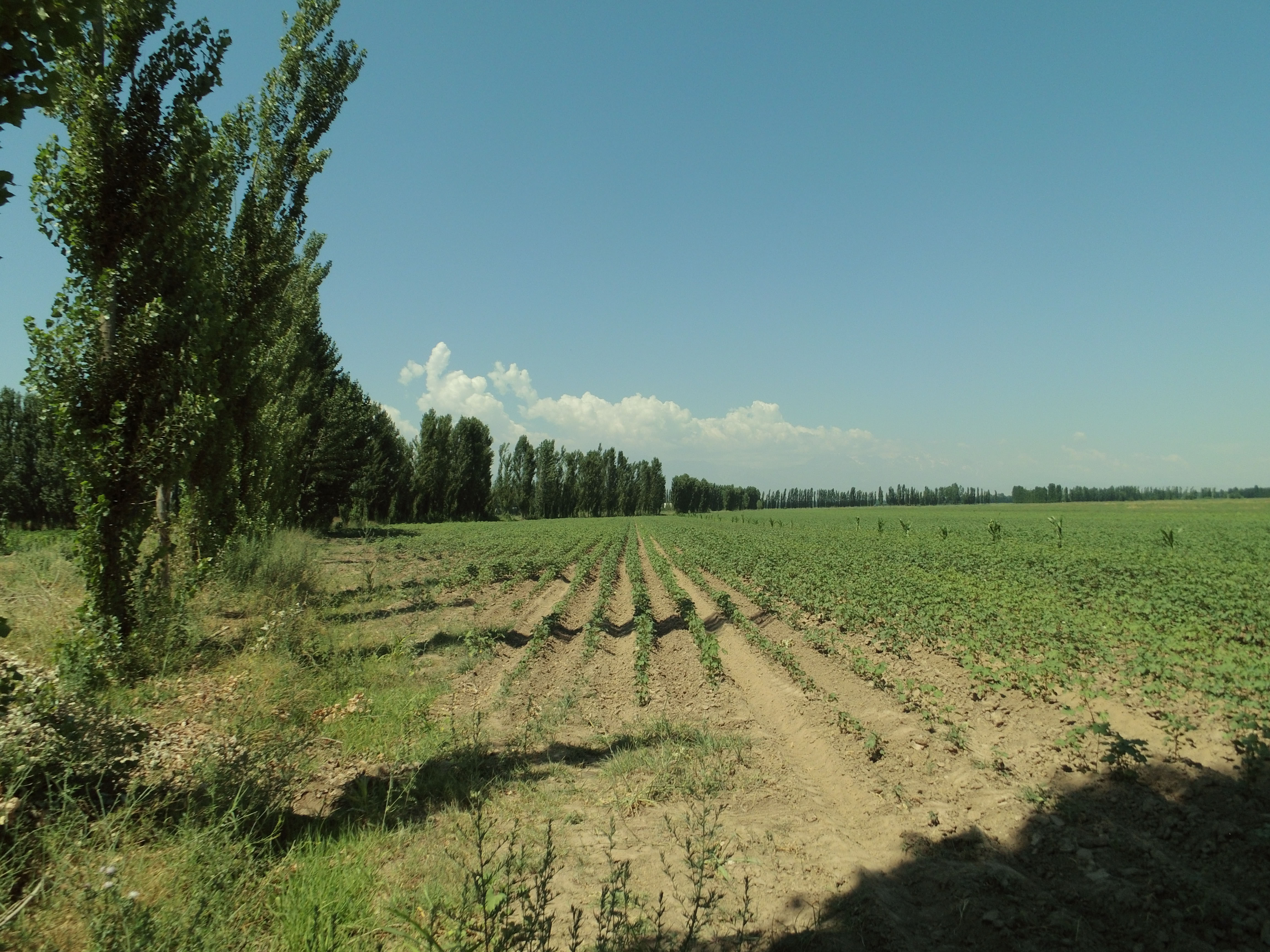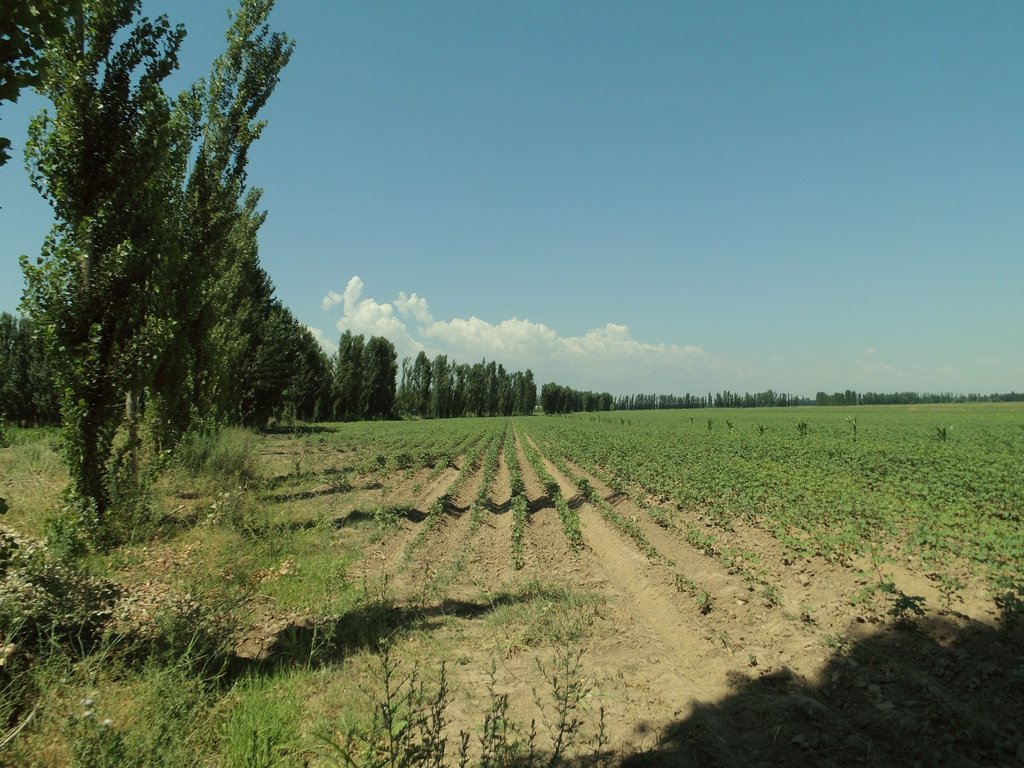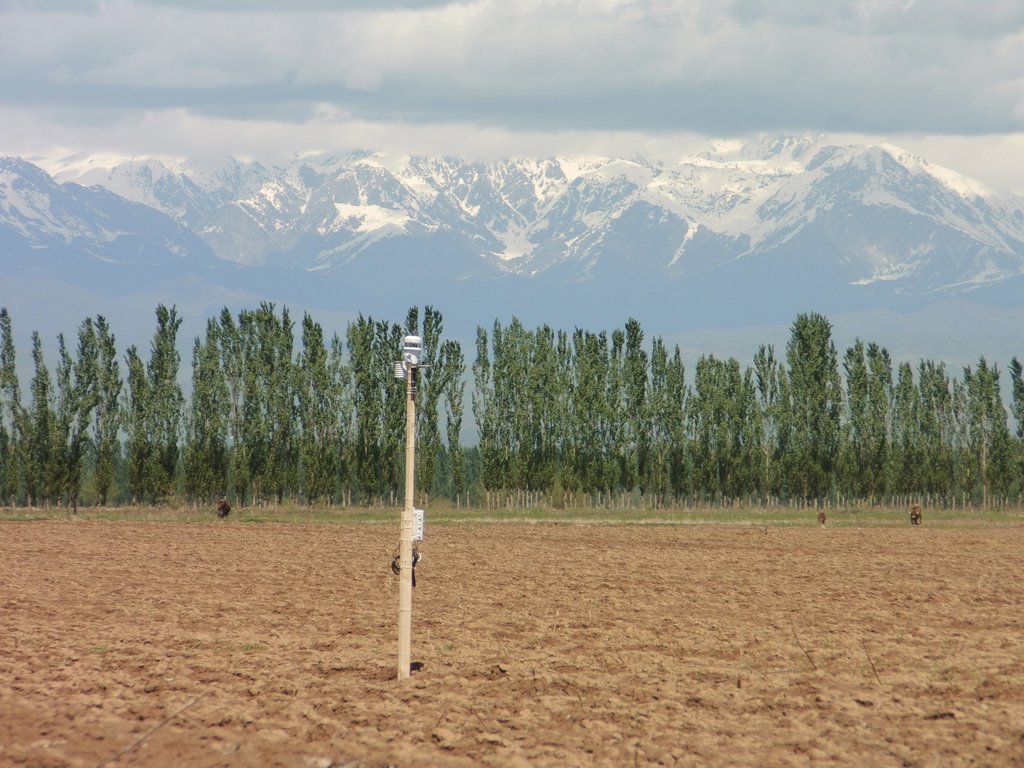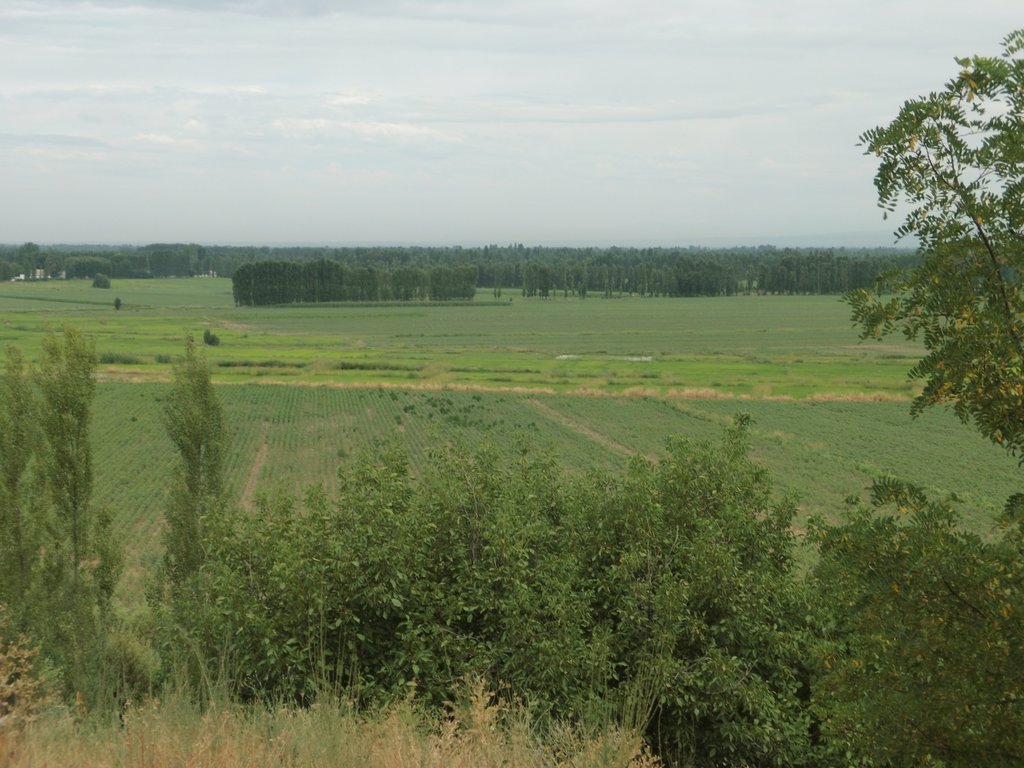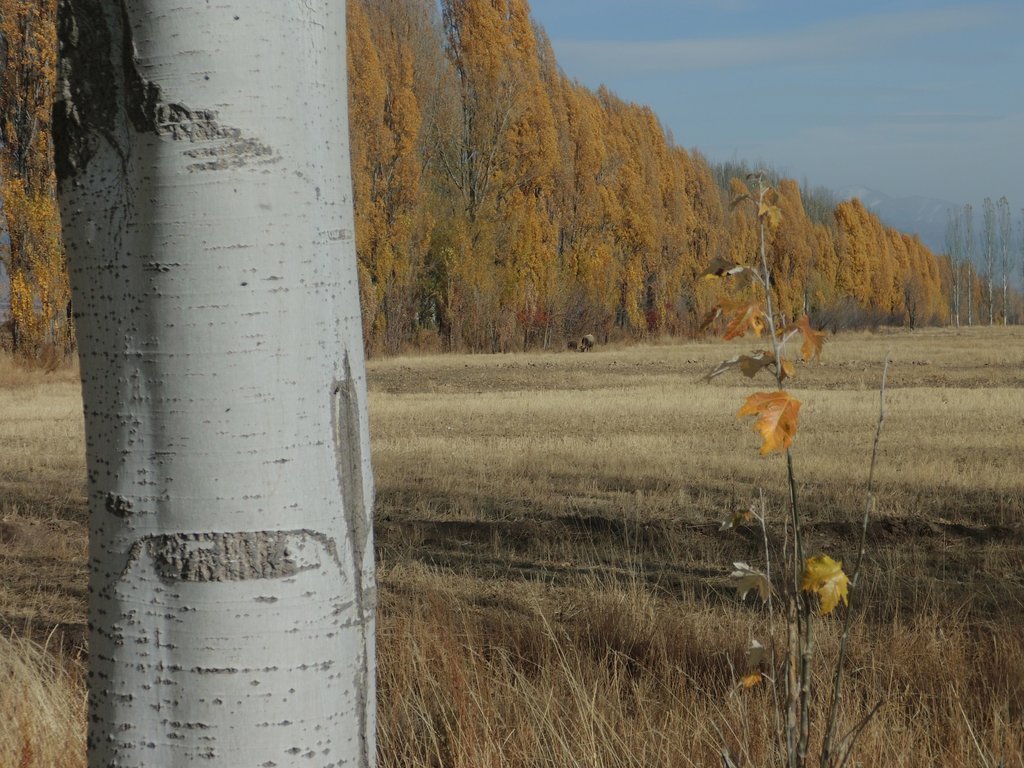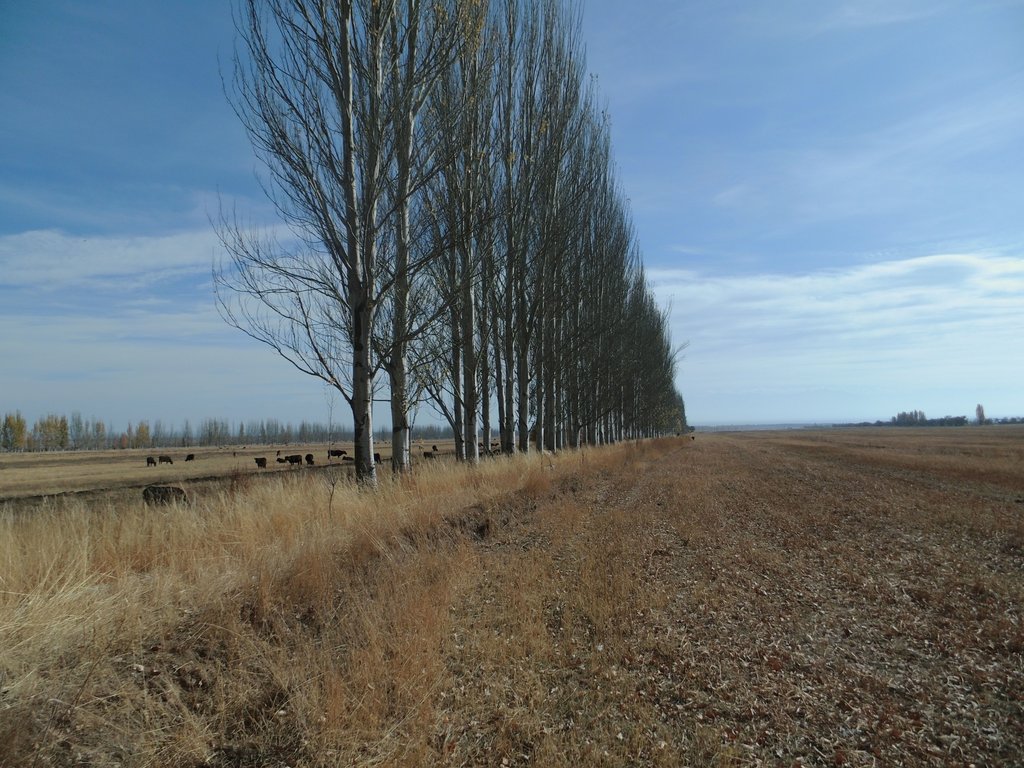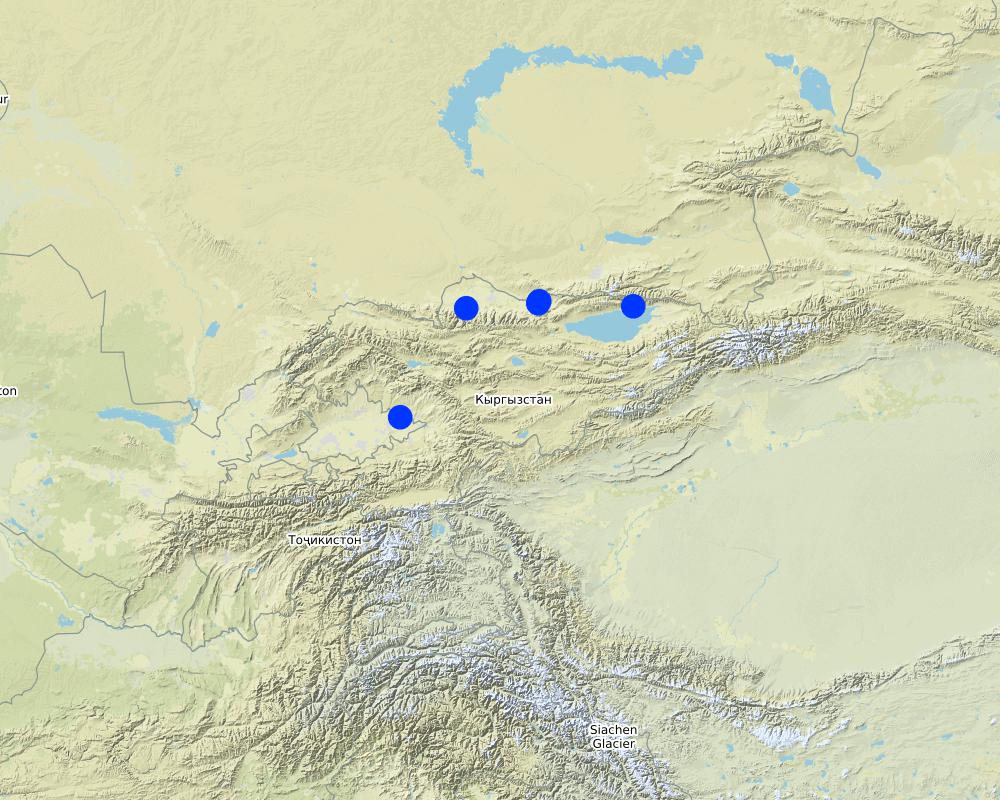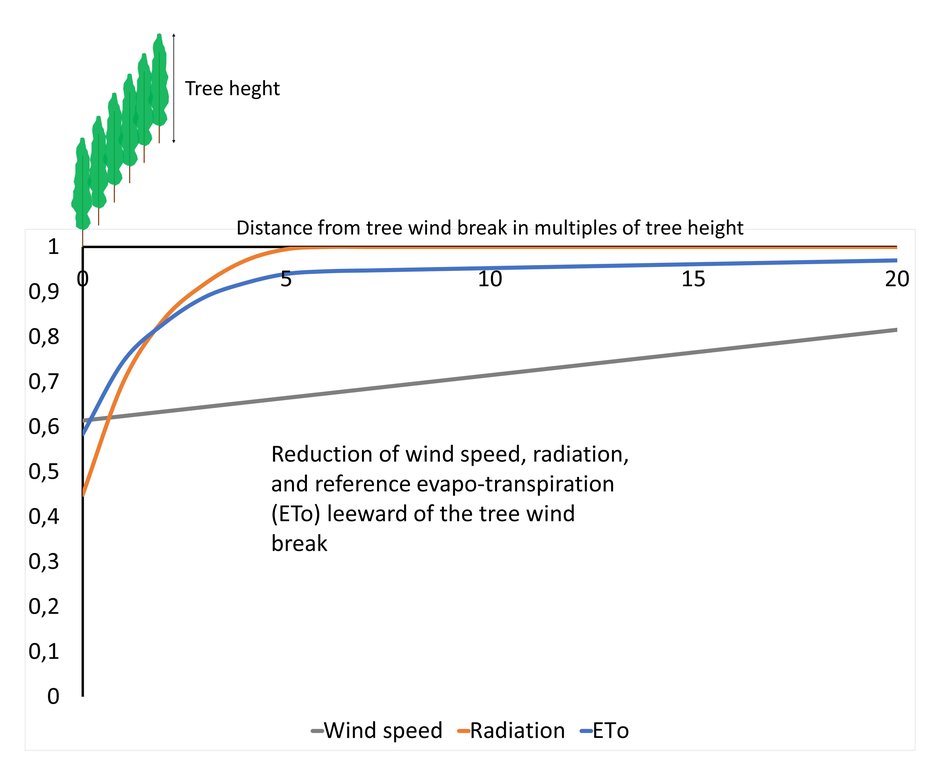Tree windbreaks within irrigated agriculture in Central Asia [Кыргызстан]
- Создание:
- Обновить:
- Составитель: Niels Thevs
- Редактор: –
- Рецензенты: William Critchley, Rima Mekdaschi Studer
technologies_5861 - Кыргызстан
Просмотреть разделы
Развернуть все Свернуть все1. Общая информация
1.2 Контактные данные специалистов и организаций, участвующих в описании и оценке Технологии
Название организации (-ий), содействовавших документированию/оценке Технологии (если применимо)
International Centre for Research in Agroforestry (ICRAF) - Кения1.3 Условия, регламентирующие использование данных, собранных ВОКАТ
Составитель и ответственный(-ые) специалист(-ы) согласны с условиями, регламентирующими использование собранных ВОКАТ данных:
Да
1.4 Декларация по устойчивости описываемой Технологии
Вызывает ли описанная здесь Технология проблемы деградации земель настолько, что ее нельзя назвать природосберегающей?
Нет
1.5 Ссылка на Анкету (ы) по Подходам УЗП (документируется с использованием ВОКАТ)
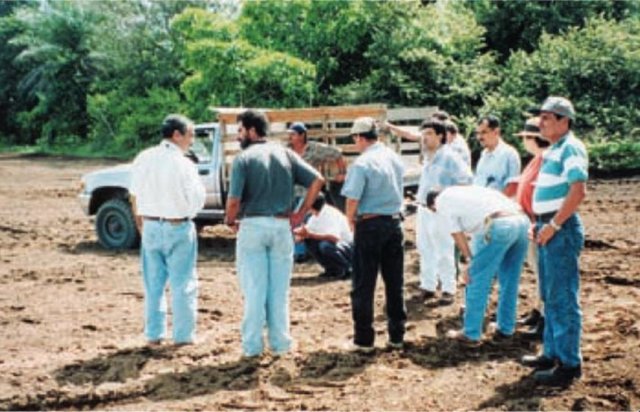
Agroforestry extension [Коста-Рика]
Participatory extension of agroforestry systems, especially of shadegrown coffee, to promote sustainable and productive use of natural resources among small and medium scale farmers.
- Составитель: Olman Quiros Madrigal
2. Описание Технологии УЗП
2.1 Краткое описание Технологии
Определение Технологии:
Windbreaks of poplar trees (Populus nigra pyramidalis) are a major agroforestry system in irrigated agriculture across Central Asia. Such windbreaks reduce the overall water consumption of irrigated agriculture by 10-20% and increase farm income by 10-15%.
2.2 Подробное описание Технологии
Описание:
Windbreaks of trees are a major agroforestry system across Central Asia. The SLM technology presented here concentrates on windbreaks, chiefly of poplar trees (Populus nigra var. pyramidalis), within irrigated agriculture. These windbreaks of poplars have a long tradition as an agroforestry system in irrigated agriculture in the river basins of south and southeastern Kazakhstan, Kyrgyzstan, Tajikistan, Turkmenistan, and Uzbekistan. In Kazakhstan and northern parts of Kyrgyzstan, poplars are partly replaced by Elm (Ulmus minor) windbreaks.
After those five countries had become independent, a large share of the windbreaks was cut down primarily for fuelwood and secondarily for timber, as the energy supply system had broken down in the course of the disintegration of the Soviet Union. Such windbreaks reduce the overall water consumption of irrigated agriculture by 10-20% compared to open field conditions, depending on crops and tree spacing (Thevs et al., 2019: doi:10.3390/land8110167). The trees serve as an additional source of income, chiefly from sustainable harvest of the trees for timber. Windbreaks also help to increase crop yields. In total, farm income is increased by 10-15% over the rotation period of the trees (Thevs and Aliev, 2021: https://doi.org/10.1007/s10457-021-00617-7). The rotation period of poplars is between 12 and 20 years, depending on the climatic conditions, e.g. poplars in the Ferghana Valles reach DBH (diametre at breast height) values of 22-27 cm and tree heights of 18 m after 13 years.
In this recent assessment, it was found that windbreaks of single tree rows with distances between trees of 1 m had the best effects on water saving and increasing farm income. The most suitable spacing between windbreaks was found to be around 200 m.
Windbreaks are perceived differently by land users depending on the region and knowledge (Ruppert et al., 2020: doi:10.3390/su12031093). For example, land users in the Ferghana Valley perceived windbreaks positively and were planting them primarily with the aim to have wood resources in the near future. In contrast, land users in the northern part of Kyrgyzstan were afraid firstly that windbreaks shaded their crops, consumed space, and competed for water and nutrients, and secondly that planting windbreaks may cause conflicts with neighbours due to those negative connotations. Farmers with larger field plots were more open towards them.
Windbreaks are planted with 2-year-old poplar saplings, which are locally available. The preferred place to plant is along irrigation ditches or other existing field boundaries. If windbreaks are planted along irrigation ditches, they simply tap water from the moist soil or elevated groundwater adjacent to those ditches. Otherwise, the trees need to be irrigated like the crops. As furrow irrigation is the dominant irrigation practice throughout Central Asia, poplars can be integrated without further adjustments in the field of irrigation. Alongside irrigation ditches poplars can withstand high water levels in those ditches as they occur during irrigation periods. If farmers switch to drip irrigation, and irrigation ditches are no longer present, the trees will need to be supplied with a dripline as well. The locally available poplar cultivars do not need additional fertilizer, but profit from the fertilizer applied to the crop. Only if high yielding modern cultivars were to be used, additional fertilizer application to the trees would be needed to unfold their full potential.
2.3 Фотографии, иллюстрирующие Технологию
2.4 Видеоматериалы, иллюстрирующие Технологию
Комментарий, краткое описание:
Video on Youtube: https://www.youtube.com/watch?v=2mAfQzO7MHg
This video provides a concise introduction into tree wind breaks, including their advantages with regards to water consumption, building resiliance against climate change, and income.
Дата:
01/09/2019
Место:
Ferghana Valley, Kyrgyzstan
Автор съемки:
Gino Carlo Garcia
Комментарий, краткое описание:
This video on Youtube, https://www.youtube.com/watch?v=Iv0VdPqBT9o, is part of a series on poplars. This part focusses on tree wind breaks with many statements of local acteurs. The other parts of this series introduce high yielding poplar cultivars and their options in agroforestry, woodlints, and value chains.
Дата:
01/02/2020
Место:
Kyrgyzstan
Автор съемки:
Lea Gerster and Stefanie Breunlich
2.5 Страна/ регион/ места, где применяется Технология, информация о которых собрана в данной Анкете
Страна:
Кыргызстан
Административная единица (Район/Область):
Jalalabad Region, Chui Region, and Issyk Kul Region
Охарактеризуйте пространственное распространение Технологии :
- равномерно-однородное применение на определенной площади
Если точная область неизвестна, укажите приблизительную площадь:
- 0,1-1 км2
Технология применяется на ООПТ?
Нет
Пояснения:
Windbreaks are spread over large areas, but the spatial distribution can be described as pockets of between 10 and 1000 ha. Within those pockets, tree wind breaks are sometimes interrupted. Also outside those pockets with more or less contiguous windbreaks systems there are remnants of those systems.
Map
×2.6 Сколько лет применяется данная Технология
Если год начала применения Технологии достоверно неизвестен, дайте примерную оценку:
- 10-50 лет назад
2.7 Внедрение Технологии
Укажите, как именно Технология УЗП была внедрена:
- как часть традиционной системы землепользования (более 50 лет назад)
3. Классификация Технологии УЗП
3.1 Основные цели и задачи реализации Технологии
- повышение производства
- адаптация к изменению климата / экстремальным погодным явлениям и их последствиям
- создание благоприятных экономических условий
3.2 Текущий(-ие) тип(-ы) землепользования на территории, где применяется Технология
Комбинированное землепользование в пределах одной и той же земельной единицы:
Да
Укажите сочетания типов землепользования (посевы / пастбища / деревья):
- Агролесоводство

Пахотные угодья и плантации
- Однолетние культуры
- Древесные и кустарниковые культуры
Ежегодный урожай - Уточните культуры:
- зерновые культуры - ячмень
- зерновые культуры - кукуруза
- зерновые культуры - рис (заболоченные территории)
- зерновые культуры - пшеница (яровая)
- зерновые культуры - пшеница (озимая)
- волокнистые культуры - хлопок
- кормовые культуры - люцерна
- корневые / клубнеплодные культуры - картофель
- Poplars
Число урожаев за год:
- 1
Применяются ли посевы в междурядьях?
Нет
Применяется ли севооборот?
Нет
3.3 Изменилось ли использование земель в связи с внедрением Технологии?
Изменилось ли использование земель в связи с внедрением Технологии?
- Нет (см. пункт 3.4)
Комбинированное землепользование в пределах одной и той же земельной единицы:
Да
Укажите сочетания типов землепользования (посевы / пастбища / деревья):
- Агролесоводство
3.4 Водоснабжение
Обеспеченность водой участков, где реализуется Технология :
- полное орошение
Пояснения:
As the spatial distribution stretches over large parts of Central Asia, some locations where windbreaks are planted are rainfed and irrigated, but most parts need full irrigation.
3.5 Категория УЗП, к которой относится Технология
- агролесоводство
- Защитные лесные насаждения
3.6 Мероприятия УЗП, выполняемые в рамках Технологии

Мероприятия с использованием растительности
- Р1: Древесный и кустарниковый покров
3.7 Основные проблемы деградации земель, на решение которых направлена Технология

ветровая эрозия почв
- Эп: утрата плодородного слоя почвы

деградация водных ресурсов
- Ва: почвенная засуха
- Вуг: изменения уровня грунтовых вод/ водоносных горизонтов
Пояснения:
The main effect of windbreaks in the assessed areas is mainly reducing water consumption, and less wind erosion. Poplars could help to lower groundwater levels and thus contribute to combat salinization. But that did not play a role in the areas specifically assessed.
3.8 Предотвращение и снижение деградации земель, или восстановление нарушенных земель
Укажите цель Технологии по отношению к деградации земель :
- снижение деградации земель
4. Технические характеристики, мероприятия по практической реализации, вложения и стоимость
4.1 Технический рисунок, иллюстрирующий Технологию
Спецификация (пояснения к техническому рисунку):
Windbreaks have their greatest impact when planted perpendicular to the main wind direction (or direction of the strongest winds). A whole grid of tree wind breaks running along all field plot borders will have a greater effect, as it prevents enhanced winds through a tunnel effect under changing wind directions. Tree wind breaks can be planted with distances of 50 m to 1000 m away from each other. The effect on the micro climate becomes less pronounced with increasing distance from tree wind breaks. Therefore, on a large field plot, say of 1000 m width between windbreaks, the micro climate averaged over the field plot will not differ much from the conditions without tree wind breaks. In contrast, on smaller field plots, say of 100 m width between windbreaks, the micro climate will differ significantly from open field conditions. This is also explained by the lines for temperature, air humidity, radiation, and in particular wind speed along an increasing distance from a given windbreak. Thereby, the distance from the windbreak is given in multiples of tree height.
In total, the best effects with regard to economic return and reduced water consumption come with a spacing of 200 m between tree wind breaks.
The best effects with regard to economic return and reduced water consumption were achieved with single tree lines. So, only one line of poplar trees is planted along the field borders. The planting distance between trees is 1 m to 1.20 m.
Poplar trees are locally available as trees with a length of 2 m to 2.50 m. Those trees are planted, best along the small irrigation ditches that run along the field borders. The local cultivar which is mainly used is a Populus nigra var. pyramidalis cultivar under the local name Mirza Terek. In principle, modern high yielding cultivars can be used as well; first research has shown a 2-3 times faster growth compared to the locally available cultivars at similar water and nutrient requirements.
Автор:
Niels Thevs
Дата:
25/03/2021
4.2 Общая информация по необходимым вложениям и стоимости
Уточните, как рассчитывались затраты и вложения:
- на площадь, где применяется Технология
Укажите размер и единицу площади:
1 ha
другая/ национальная валюта (название):
KGS
Если это необходимо, укажите обменный курс от доллара США к местной валюте (например, 1 доллар США = 79,9 бразильского реала): 1 доллар США =:
68,87
Укажите среднюю дневную заработную плату наемных работников:
750
4.3 Мероприятия, необходимые для начала реализации
| Деятельность | Время (сессия) | |
|---|---|---|
| 1. | Tree planting | March (first year) |
| 2. | Maintenance of trees | April to September (first and second year) |
| 3. | Harvest of trees | December to February (last year of tree rotation - after 15 years) |
Пояснения:
These entries refer to a windbreak system of poplars to be harvested at tree age of 15 years combined with cotton. Thereby, the activities related to trees, including the harvest, are considered as activities to establish windbreaks into an agrarian landscape where irrigated agriculture is ongoing. The annual crop related activities are therefore listed under maintenance. If cotton is rotated with corn or rice, the timing of the crop-related activities is similar.
4.4 Вложения и затраты, необходимые для начала реализации
| Опишите затраты | Единица | Количество | Затраты на единицу | Общая стоимость на единицу | % затрат, оплаченных землепользователями | |
|---|---|---|---|---|---|---|
| Оплата труда | Labor costs for tree planting and maintenance (first year) | man-days | 3,0 | 750,0 | 2250,0 | 100,0 |
| Оплата труда | Labor costs for tree maintenance (second year) | man-days | 3,0 | 650,0 | 1950,0 | 100,0 |
| Оборудование | Labor costs to harvest trees (at tree age 15 years) | man-days | 3,0 | 70,0 | 210,0 | 100,0 |
| Посадочный материал | Poplar saplings | sapling | 116,0 | 20,0 | 2320,0 | 100,0 |
| Посадочный материал | Transport of saplings | 500,0 | 1,0 | 500,0 | 100,0 | |
| Общая стоимость запуска Технологии | 7230,0 | |||||
| Общие затраты на создание Технологии в долларах США | 104,98 | |||||
Пояснения:
Costs had been retrieved for the year 2017. Costs that appear in the second year and later were discounted at a discount rate of 17.5% based on costs as of 2017.
4.5 Поддержание/ текущее обслуживание
| Деятельность | Сроки/ повторяемость проведения | |
|---|---|---|
| 1. | Soil preparation and sowing of annual crop (cotton) | March to April / every year |
| 2. | Irrigation, fertilizer application and other farm operations for the crop | April to August / every year |
| 3. | Harvest of the crop (cotton) | September to October / every year |
4.6 Стоимость поддержания/ текущего обслуживания ( в год)
| Опишите затраты | Единица | Количество | Затраты на единицу | Общая стоимость на единицу | % затрат, оплаченных землепользователями | |
|---|---|---|---|---|---|---|
| Оплата труда | Labor costs for soil preparation | man-days | 6,81 | 750,0 | 5107,5 | 100,0 |
| Оплата труда | Labor costs for sowing | man-days | 2,5 | 750,0 | 1875,0 | 100,0 |
| Оборудование | Labor costs for irrigation | man-days | 23,64 | 750,0 | 17730,0 | 100,0 |
| Оборудование | Labor costs to apply fertilizer and plant protection | man-days | 3,34 | 750,0 | 2505,0 | 100,0 |
| Оборудование | Labor costs for harvest (cotton) | man-days | 32,78 | 554,0 | 18160,12 | 100,0 |
| Оборудование | Machine costs (rent) for soil preparation | ha | 1,0 | 10021,0 | 10021,0 | 100,0 |
| Оборудование | Machine costs (rent) for sowing | ha | 1,0 | 1316,0 | 1316,0 | 100,0 |
| Оборудование | Machine costs for fertilizer application | ha | 1,0 | 1200,0 | 1200,0 | 100,0 |
| Посадочный материал | Seeds | kg | 50,0 | 101,0 | 5050,0 | 100,0 |
| Удобрения и ядохимикаты | Fertilizer | kg | 375,0 | 19,25 | 7218,75 | 100,0 |
| Удобрения и ядохимикаты | Plant protection | ha | 1,0 | 1517,0 | 1517,0 | 100,0 |
| Другие | Water fee | ha | 1,0 | 1014,0 | 1014,0 | 100,0 |
| Общая стоимость поддержания Технологии | 72714,37 | |||||
| Общие затраты на поддержание Технологии в долларах США | 1055,82 | |||||
4.7 Наиболее значимые факторы, влияющие на стоимость затрат
Опишите наиболее значимые факторы, влияющие на стоимость затрат:
Labour costs are the largest single cost item. In fact, in the cotton system a lot of labour is unpaid family labour or mutual help among neighbours. All labour was calculated in monetary terms, as the share of unpaid labour differed much between farms. This cotton tree wind break system is wide spread in the south of Kyrgyzstan. In the north of the country, tree wind breaks are combined with wheat, barley, corn, or alfalfa (lucerne). There, labour costs are lower as more machines are used (e.g. for harvest).
5. Природные и социально-экономические условия
5.1 Климат
Среднегодовое количество осадков
- < 250 мм
- 251-500 мм
- 501-750 мм
- 751-1000 мм
- 1001-1500 мм
- 1501-2000 мм
- 2001-3000 мм
- 3001-4000 мм
- > 4000 мм
Пояснения/ комментарии по осадкам:
Precipitation maximum during spring and dry summers, which makes irrigation necessary.
Укажите название соответствующей метеостанции:
Bazarkorgon, Kara Balta, Kemin
Агроклиматическая зона
- полузасушливая
hot continental and semi-arid
5.2 Рельеф
Склоны (преобладающие):
- пологие (0-2%)
- покатые (3-5%)
- покато-крутые (6-10%)
- крутые (11-15%)
- очень крутые (16-30%)
- чрезвычайно крутые (31-60%)
- обрывистые (>60%)
Формы рельефа:
- плато/ равнины
- гребни хребтов/холмов
- склоны гор
- склоны холмов
- подножья
- днища долин
Зона высотной поясности:
- 0-100 м над уровнем моря
- 101-500 м н.у.м.
- 501-1000 м н.у.м.
- 1001-1500 м н.у.м.
- 1501-2000 м н.у.м.
- 2001-2500 м н.у.м.
- 2501-3000 м н.у.м.
- 3001-4000 м н.у.м.
- > 4 тыс. м н.у.м.
Комментарии и дополнительные сведения по условиям рельефа/ топографии :
Tree windbreaks can be applied in a wide range of topographical situations. Though this particular entry focusses on windbreaks in irrigated agriculture so that the whole SLM technique, i.e. trees and crops, is distributed on flat land. As irrigation is tied to rivers as water sources, this SLM technique is distributed on river plains.
5.3 Почвы
Средняя мощность почв:
- поверхностные (0-20 см)
- неглубокие (21-50 см)
- умеренно глубокие (51-80 см)
- глубокие (81-120 см)
- очень глубокие (> 120 см)
Гранулометрический состав (верхнего горизонта):
- средние фракции (суглинистый, супесчаный)
Гранулометрический состав (на глубине более 20 см):
- средние фракции (суглинистый, супесчаный)
Содержание органического вещества в верхнем горизонте:
- среднее (1-3%)
Если возможно, приложите полное описание почв или укажите доступную информацию, например тип почв, рH/ кислотность почв, ёмкость катионного обмена, содержание азота, содержание солей и т.д.
Tree windbreaks per se are not limited to specific soil types. In the region considered here, the soils that are irrigated and therefore are sites for this SLM technique were mostly formed by riparian deposits. Those soils silty to loamy. On most of those areas, where irrigation takes place, soils are classified as Fluvisols. On few areas, the soils are classified as Gleysols.
5.4 Доступность и качество воды
Уровень грунтовых вод:
< 5 м
Доступность поверхностных вод:
хорошая
Качество воды (без обработки):
исключительно для сельскохозяйственного использования (орошение)
Качество воды относится к:
поверхностные воды
Является ли солёность воды проблемой?
Нет
Происходят ли периодические затопления территории?
Нет
Комментарии и дополнительная информация по качеству и количеству воды:
Soil salinization and waterlogging do not play a role on the sites from where the information was collected for this introduction here. Though in parts of Kazakhstan, Uzbekistan, and Turkmenistan, where this windbreak SLM technology is being applied and can be expanded as well, salinization and water logging do play a role.
5.5 Биоразнообразие
Видовое разнообразие:
- средняя
Разнообразие местообитаний:
- средняя
5.6 Характеристика землепользователей, применяющих Технологию
Осёдлый или кочевой:
- Осёдлый
Рыночная ориентация производства:
- смешанный (натуральный / коммерческий)
Доходы из других источников:
- 10-50% всех доходов
Относительный уровень достатка:
- средний
Индивидуальное или коллективное хозяйство:
- частное/ домовладение
- группа/ община
Уровень механизации:
- ручной труд
- механизировано/ есть автотранспорт
Пол:
- мужчины
Возраст землепользователей:
- средний возраст
Укажите другие важные характеристики землепользователей:
In Kyrgyzstan, the land users operate as households and can decide on their crops. Though, planting tree windbreaks does take place in agreement with neighbours. In Uzbekistan, where windbreaks are used as well, the freedom of farmers to chose their crops is limited, while tree windbreak planting partly follows governmental orders. In both countries as well as Tajikistan, labour migration is important for most rural families and remittances comprise a substantial share of the household income (off-farm income).
5.7 Средняя площадь земель, используемых землепользователями с применением Технологии
- < 0,5 га
- 0,5-1 га
- 1-2 га
- 2-5 га
- 5-15 га
- 15-50 га
- 50-100 га
- 100-500 га
- 500-1000 га
- 1000-10000 га
- > 10000 га
Считается ли это мелким, средним или крупным хозяйством (по местным масштабам)?
- среднего размера
5.8 Собственность на землю, права на земле- и водопользование
Землевладелец:
- индивидуальная, оформленная в собственность
Право землепользования:
- аренда
- индивидуальное
Право водопользования:
- общинное (контролируемое)
Права на землепользование основаны на традиционной правовой системе?
Да
5.9 Доступ к базовым услугам и инфраструктуре
медицинское обслуживание:
- плохой
- средний
- хорошая
образование:
- плохой
- средний
- хорошая
технические консультации:
- плохой
- средний
- хорошая
занятость (вне хозяйства):
- плохой
- средний
- хорошая
рынки:
- плохой
- средний
- хорошая
электроснабжение:
- плохой
- средний
- хорошая
транспорт и дорожная сеть:
- плохой
- средний
- хорошая
водоснабжение и канализация:
- плохой
- средний
- хорошая
финансовые услуги:
- плохой
- средний
- хорошая
6. Воздействия и заключительные положения
6.1 Влияние Технологии УЗП в пределах территории ее применения
Социально-экономическое воздействие
Продуктивность
производство сельскозяйственных культур
Комментарий/ пояснения:
There is agreement in the scientific literature that tree windbreaks cause crop yield increases of 10-15%. Some references even claim crop yield increases of up to 40%.
производство кормов
Комментарий/ пояснения:
The leaves of the trees are partly used as fodder. But that additional fodder only is a minor contribution to the overall fodder demand.
производство древесины
Количество до применения УЗП :
none
Количество после применения УЗП:
53 m³/ha after 15 years
Комментарий/ пояснения:
Trees are harvested at an age of 15 years. Such trees have an average tree height and DBH of 19 m and 27 cm, respectively. Given a form factor of 0.42 one tree yields a stem volume of 0.457 m³. A number of 116 trees is assigned to 1 ha, which results in 53 m³/ha.
площадь, используемая для производства продукции
Количество до применения УЗП :
1 ha cropland
Количество после применения УЗП:
0.9 ha cropland
Комментарий/ пояснения:
Tree wind breaks occupy space so that the area available to the crop gets reduced. While the trees do not occupy substantial space during their first years of growth, they occupy about 10% of the cropland at and age of 10-15 years. This calculation was made for a spacing between tree wind breaks of 200 m.
управление землями
Комментарий/ пояснения:
Tree windbreaks at a spacing of 200 m do not impede farm operations, while narrower spacing may disturb farm operations, in particular with machines.
Доступность и качество воды
потребность в оросительной воде
Количество до применения УЗП :
904 mm over the cropping season
Количество после применения УЗП:
777 mm over the cropping season
Комментарий/ пояснения:
ETc (water consumption) of cotton is 904 mm over the whole cropping season. Tree windbreaks (arranged as a rectangular grid with a spacing of 200 m) with cotton together consume 777 mm over the whole cropping season. (cf. comment below under evaporation)
Доходы и затраты
сельскохозяйственные издержки
Комментарий/ пояснения:
There are expenses for tree planting material and labour associated to tree planting and maintenance during the first and second year.
доходы хозяйства
Количество до применения УЗП :
Accumulated NPV after 15 years: 214,000 KSG/ha
Количество после применения УЗП:
Accumulated NPV after 15 years: 232,000 KSG/ha
Комментарий/ пояснения:
The accumulated NPV over 15 years for cotton versus cotton and tree wind breaks were compared to assess the financial gain from tree wind break systems. 15 years is the tree age at which the tree wind breaks are harvested. Costs and revenues were discounted at a discount rate of 17.5%.
разнообразие источников дохода
Комментарий/ пояснения:
Wood resources are added as additional income next to crops.
Экологическое воздействие
Водный цикл/ поверхностный сток
испарение
Количество до применения УЗП :
904 mm over the cropping season
Количество после применения УЗП:
777 mm over the cropping season
Комментарий/ пояснения:
ETc (water consumption) of cotton is 904 mm over the whole cropping season. Tree win breaks (arranged as a rectangular grid with a spacing of 200 m) with cotton together consume 777 mm over the whole cropping season. (cf. comment above under irrigation water demand)
Почвы
влажность почв
Комментарий/ пояснения:
As tree wind breaks reduce evapotranspiration, they help to maintain soil moisture.
утрата почв
Комментарий/ пояснения:
Wind erosion did not play a role in this example of cotton combined with tree windbreaks. Though in other parts of Kyrgyzstan or Central Asia stronger winds prevail than in this very example. There, tree wind breaks do combat wind erosion.
засоленность
Комментарий/ пояснения:
Salinity did not play a role in this example of cotton combined with tree windbreaks. Though in other parts of Kyrgyzstan or Central Asia salinity does play a role. There, windbreaks, in particular poplar trees, help to lower the groundwater levels due to their high water consumption, which helps to combat soil salinization.
почвенное / подземное органическое вещество/ углерод
Комментарий/ пояснения:
The leaves of the trees partly end up as litter on the soil surface. The trees' root systems add to the below ground biomass. Both contribute to the formation of soil organic matter. Though, this is limited to a small area adjacent to the tree wind breaks and does not translate into the area of the cropland.
6.2 Влияние Технологии за пределами территории ее применения
доступность воды
Комментарий/ пояснения:
As the evapotranspiration (water consumption) and the demand for irrigation water are reduced, the general availability of water is increased.
ущерб прилегающим полям
Комментарий/ пояснения:
Neighboring fields are partly shaded.
6.3 Подверженность и чувствительность Технологии УЗП к постепенным изменениям климата и экстремальным погодным явлениям/ стихийным бедствиям, связанным с изменением климата (в понимании землепользователей)
Другие воздействия, связанные с изменением климата
Другие воздействия, связанные с изменением климата
| Насколько успешно Технология справляется с этим? | |
|---|---|
| Glacier retreat which will result in reduced river flows and supply of water for irrigation |
Пояснения:
There are two major effects of climate change on the region Central Asia: 1. Glacier retreat through rising temperatures and 2. increasing rainfall during winter and partly reduced snow. Currently, the melting glaciers cause elevated river flows so that there is more water available for irrigation. But, once the glaciers have reached a new equilibrium with smaller glacier volumes, they will deliver less water so that river flows are expected to drop during the second half of this century. Then, the supply of water for irrigation will become constrained. Tree windbreaks are one option to adapt to those conditions in the future.
6.4 Анализ эффективности затрат
Насколько получаемый результат сопоставим с первоначальными вложениями (с точки зрения землепользователей)?
Эффективность затрат в краткосрочной перспективе:
влияние незаметно
Эффективность затрат в долгосрочной перспективе:
позитивное
Насколько получаемый результат сопоставим с текущими расходами по поддержанию технологии (с точки зрения землепользователей)?
Эффективность затрат в краткосрочной перспективе:
позитивное
Эффективность затрат в долгосрочной перспективе:
позитивное
6.5 Внедрение Технологии
- 1-10%
Среди применяющих Технологию землепользователей, какова доля лиц, применяющих её по собственной инициативе, т.е. без какого-либо материального стимулирования со стороны?
- 91-100%
6.6 Адаптация
Была ли Технология УЗП изменена в недавнее время с целью адаптации к меняющимся условиям среды?
Да
Укажите, что именно изменилось в Технологии (дизайн, используемые материалы или виды растений/животных и т.д.):
During the Soviet Union times, when tree windbreaks were promoted, multi-row tree windbreaks were planted. Today, farmers prefer single tree lines, in order not to sacrifice too much crop space.
6.7 Сильные стороны/ преимущества/ возможности Технологии
| Сильные стороны/ преимущества/ возможности по мнению землепользователей |
|---|
| Tree windbreaks deliver wood resources for self consumption or to be sold on markets. |
| In more windy parts of Kyrgyzstan or Central Asia, land users see the advantage of reduced wind speed for crop quality and snow trap to build up soil moisture. |
| Сильные стороны/ преимущества/ возможности по мнению составителя или других ключевых специалистов |
|---|
| Tree windbreaks provide additional income as they deliver wood resources. |
| Tree windbreaks reduce overall water consumption in irrigated agriculture. |
| In more windy parts of Kyrgyzstan or Central Asia, land users see the advantage of reduced wind speed for crop quality and snow trap to build up soil moisture. |
6.8 Слабые стороны/ недостатки/ риски Технологии и пути их преодоления
| Слабые стороны/ недостатки/ риски по мнению землепользователей | Возможные пути их преодоления/снижения? |
|---|---|
| Tree windbreaks shade the crop. | Capacity building and explain that this is a minor effect. |
| Tree windbreaks compete with the crops for nutrients and water. | Capacity building and explain that this is a minor effect. |
| Tree windbreaks disturb farm operations. | Capacity building and explain that this is a minor effect. |
| Tree windbreaks cause conflict with neighbours, as neighbours may share those negative perceptions. | Capacity building and explain that this is a minor effect and promote cooperation between neighbors to share benefits from tree wind breaks. |
| Слабые стороны/ недостатки/ риски по мнению составителя или ответственных специалистов | Возможные пути их преодоления/снижения? |
|---|---|
| Financial resources are needed to establish tree windbreaks, while the revenue from the harvest of trees only can be realized in the future. | Access to suitable finance. |
7. Справочные материалы и ссылки
7.1 Методы сбора/ источники информации
- выезды на места, полевые обследования
Regular field visits (every 14 days) on three sites to collect climate, crop, and tree data to, among others, calculate crop and tree water consumption.
Field visit to two additional sites to collect data on tree growth.
- опросы землепользователей
62 household interviews to collect agro-economic numbers on crops and trees.
15 household interviews with wood traders and wood processors to collect information on markets and prices of wood from tree wind breaks.
80 semi-structured interviews on perception of tree wind breaks by farmers.
- данные, собранные из отчетов и достоверных документов
compilation of literature on tree windbreaks, from Soviet Union and recent international literature.
Когда были собраны данные (на местах)?
14/07/2017
Пояснения:
July 2017 was the most busy time to collect the interviews on agro-economy and wood markets. The interviews on farmers' perceptions of tree windbreaks were collected during September and October 2018. Crop and tree data (growth, water consumption) were collected during 2017 and 2018.
7.2 Ссылки на опубликованные материалы
Название, автор, год публикации, ISBN:
Thevs N, Aliev K (2021): Agro-economy of tree windbreak systems in Kyrgyzstan, Central Asia. Agroforestry Systems. https://doi.org/10.1007/s10457-021-00617-7
Где опубликовано? Стоимость?
Agroforestry Systems, EUR 37.40
Название, автор, год публикации, ISBN:
Ruppert D, Welp M, Spies M, Thevs N (2020): Farmers’ perceptions of tree shelterbelts on agricultural land in rural Kyrgyzstan. Sustainability 12:1093. doi:10.3390/su12031093
Где опубликовано? Стоимость?
https://www.mdpi.com/2071-1050/12/3/1093 - open access
Название, автор, год публикации, ISBN:
Thevs N, Gombert AJ, Strenge E, Lleshi R, Aliev K, Emileva B (2019): Tree wind breaks in Central Asia and their effects on agricultural water consumption. Land, 8: 167-183. https://doi.org/10.3390/land8110167
Где опубликовано? Стоимость?
https://www.mdpi.com/2073-445X/8/11/167 - open access
Название, автор, год публикации, ISBN:
Strenge E, Thevs N, Aliev K, Eraaliev M, Lang P, Baibagysov A (2018): Water consumption of Populus alba trees in tree shelterbelt systems in Central Asia. Central Asian Journal for Water Resources 4, 48-62
Где опубликовано? Стоимость?
https://www.water-ca.org/api/v1/articles/5955-water-consumption-of-populus-alba-trees-in-tree-shelterbelt-systems-in-central-asia.pdf - open access
Название, автор, год публикации, ISBN:
Thevs N, Aliev K, Lleshi R (accepted): Water Productivity of Tree Wind Break Agroforestry Systems in Irrigated Agriculture – an example from Ferghana Valley, Kyrgyzstan. Trees, Forests, and People
Где опубликовано? Стоимость?
will be open access
7.3 Ссылки на соответствующую онлайн-информацию
Название/ описание:
UNECE (2019): Forest Landscape Restoration in the Caucasus and Central Asia – Challenges and Opportunities. Background paper for the Ministerial Roundtable on Forest Landscape Restoration in the Caucasus and Central Asia (21-22 June 2018, Astana, Kazakhstan)
Адрес в сети Интернет:
http://www.unece.org/fileadmin/DAM/timber/publications/DP-72-flr-cca-en.pdf
Название/ описание:
Agroforestry and Central Asia
Адрес в сети Интернет:
https://www.youtube.com/watch?v=2mAfQzO7MHg
7.4 Общие комментарии
The questionaire guides the compiler through a number of questions through often standardized questions (ticking boxes). This is very helpful to avoid, possibly lengthy and not too concise descriptions. But with regard to agroforestry it should be made more clear where and how to address the trees.
In total it needs time to go through and fill in all sections, which surely is owed to the wish and need to collect information for a comprehensive description of each SLM technology. But, towards the end of projects, which have developed such technologies, the workload might be too high so that the entry into WOCAT is neglected. I guess one only can appeal to the motivation of projects or offer some sort of support for NGOs or so in need, but with very good SLM technologies to offer.
Ссылки и модули
Развернуть все Свернуть всеСсылки

Agroforestry extension [Коста-Рика]
Participatory extension of agroforestry systems, especially of shadegrown coffee, to promote sustainable and productive use of natural resources among small and medium scale farmers.
- Составитель: Olman Quiros Madrigal
Модули
Нет модулей


